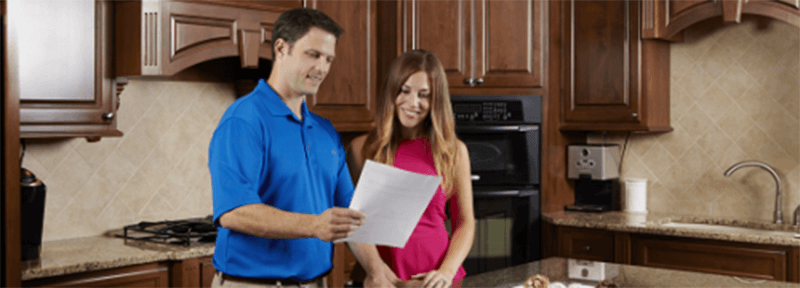
Most people don’t think about their air conditioning and heating system until it breaks or becomes so old it is not worth repairing. In fact, a recent survey of U.S. homeowners, conducted by Copeland suggests that 59 percent of people who bought new HVAC systems in the past two years were buying due to the failure of their existing system or the costly repairs required to keep it running. This is in contrast to the 56 percent who, when they were just beginning to consider a new HVAC system, were mostly focused on energy efficiency and comfort benefits before their system failed (i.e., before their old system broke). They had no time to gather information and no time to get quotes from multiple installers.
The survey of approximately 1,500 U.S. homeowners also suggests that most homeowners are very concerned with the long-term reliability and operating costs related to their HVAC system. It is also important to them that the system always provides the desired temperature throughout the entire home, all year round and in all seasons – not just on extreme days.
The conclusions that homeowners can take away from this complex study were both revealing and amazingly simple:
- Your HVAC is a “big deal”
- Don’t wait too long to replace your old system (and do your homework)
- It’s all about the contractor (and you have a choice)
- Plan ahead (for an approximate $8,000 replacement cost)
Your HVAC is a BIG DEAL
Homeowners tend to focus on aesthetic improvements, such as home improvement items like fancy countertops and hardwood floors, but it is what isn’t often seen that can make all the difference. The U.S. Department of Energy states that the air conditioning and heating system in your home represents 40 percent of your total annual energy costs. This is more than water heating (13 percent) and lighting (9 percent).
Your HVAC is also probably one of the more expensive appliances you own (approximately $8,000 in replacement costs) and it uses more energy than almost all of your other major appliances combined. I know, it is confusing, but it is out there in the yard or in the basement, keeping you cool or warm when you need it.
The survey results also indicated that the home AC system was the appliance that homeowners would not want to live without in the heat of the summer – 31 percent voted for AC, ahead of refrigerators (28 percent) and home security (11 percent). The margin was even higher in the Southeast region, where the AC priority in this survey reached 43 percent. Unfortunately, most people do not know much about their HVAC system. Over half (57 percent) of the respondents did not know the efficiency level of their HVAC system and 11 percent did not know the age of their current system.
Don’t wait too long to replace your old system (and do your homework)
The average age of a HVAC system in the U.S. is about 12 to 13 years old. The average age of systems when they are replaced is just 16 years old, but the lifespan could range from around 5 years to over 25 years.
It is not about the age of your system, but rather the run time; just like your car, it is not the years, it’s the miles. In the case of HVAC, how much you run it determines its useful remaining life. For example, the average useful life is lower than average in the Southeast at 14 years old, where the combination of long run times in the summer and the high adoption of heat pumps in the winter take it its toll on system life.
If you have an older system (16 years+) or one that has been having frequent problems, now is the time to decide on a new system and choose a reputable installation and service provider.
The Copeland survey indicated that 21 percent of “satisfied” HVAC consumers did online research using independent help sites and forums like AC & Heating Connect versus the “not satisfied” group at 15 percent. In verbatim comments, consumers who had recently purchased new HVAC systems were asked to provide any advice to other buyers and the most common response was, “research EVERYTHING” before buying. Putting time on your side before purchasing a new HVAC system can save you time and money in the end.
It’s all about the contractor (and you have a choice)
The Copeland survey indicated that 81 percent of satisfied HVAC consumers reported relying heavily on their contractor/installer as they made their purchase decisions, versus just 28 percent of the non-satisfied group.
In addition, 85 percent of the consumers who were satisfied with their contractor were satisfied with the system they chose to purchase, versus only 41 percent of those not satisfied with their contractor.
Once you select a contractor, make sure that you engage in a conversation about the various higher efficiency systems; 88 percent of the satisfied group had these discussions versus just 67 percent with the dissatisfied group (even if they did not end up buying the high efficiency models).
This is important because the difference between just a point or two of Seasonal Energy Efficiency Ratio (SEER) for your air conditioner can affect your energy bill by hundreds of dollars per season. The satisfied group showed a higher incidence (35 percent) of contractor inspections of ductwork, insulation and square footage than the dissatisfied group (27 percent).
If your system is not properly sized or installed, you might not be realizing the energy savings you were expecting and you might not be satisfied with the comfort (temperature and humidity control) your new system provides. Hiring a thorough contractor who takes the time to explain this and what it means to your energy costs and overall comfort is essential to being satisfied with your purchase.
Plan ahead (for an approximate $8,000 replacement cost)
The survey indicated that the average replacement cost for an HVAC system was about $8,400, but could range from less than $5,000 to over $20,000, depending on the size of your system and whether it’s a partial replacement (e.g. outdoor AC unit only) or a full system replacement that includes both AC and furnace, while upgrading to higher efficiencies. Although the survey indicated that 87 percent of respondents in the market had an accurate plan for how much they were going to pay for their new system, two of the top four reasons given for why they had not yet purchased were related to finances – “too expensive” and “can’t afford.”
In conclusion
Your HVAC system is one of the more important appliances in your home. If your system is older or beginning to fail, you can save both time and money and increase the satisfaction with your replacement if you do your research up front, plan for financing and find a good contractor to help you make these decisions.
Waiting until your old system breaks in the heat of the summer or the cold of the winter can lead to costly mistakes that can haunt you and your family for many years after your new system is installed.
By the numbers
- 56 percent of people, when they were just beginning to consider a new HVAC system, were mostly focused on energy efficiency and comfort benefits before their system failed.
- 59 percent of people who actually purchased new HVAC systems in the past two years were buying due to the failure of their existing system or the costly repairs required to keep it running.
- Home HVAC represents 40 percent of your home’s total annual energy costs.
- The number one appliance that homeowners would not want to live without in the heat of the summer is their air conditioner – according to 31 percent of those surveyed.
- Over half (57 percent) of the respondents did not know the efficiency level of their HVAC system.
- 11 percent of the respondents did not know the age of their current system.
- The average age of HVAC systems in the U.S. is about 12 to 13 years old.
- The average age of systems when they are replaced is just 16 years old.
- 21 percent of “satisfied” HVAC consumers did online research using independent help sites and forums like AC & Heating Connect, versus the “not satisfied” group at 15 percent.
- 81 percent of satisfied HVAC consumers reported relying heavily on their contractor/installer as they made their purchase decisions, versus just 28 percent of the non-satisfied group.
- 85 percent of the consumers who were satisfied with their contractor were also satisfied with the system they chose to purchase versus only 41 percent of those not satisfied with their contractor.
- 88 percent of the satisfied group had discussions with their contractor about high-efficiency system alternatives, versus just 67 percent with the dissatisfied group – even if they did not end up buying the high-efficiency models.
- The satisfied group showed a higher incidence (35 percent) of contractor inspections of ductwork, insulation and square footage than the dissatisfied group (27 percent).
- The average replacement cost for an HVAC system was about $8,400 but could range from less than $5,000 to over $20,000.
- Two of the top four reasons given for why consumers had not purchased a new HVAC system yet were related to financing – “too expensive” and “can’t afford”.
- Consumers who had recently purchased new HVAC systems were asked to provide any advice to other buyers and the most common response was “research EVERYTHING” before buying.



